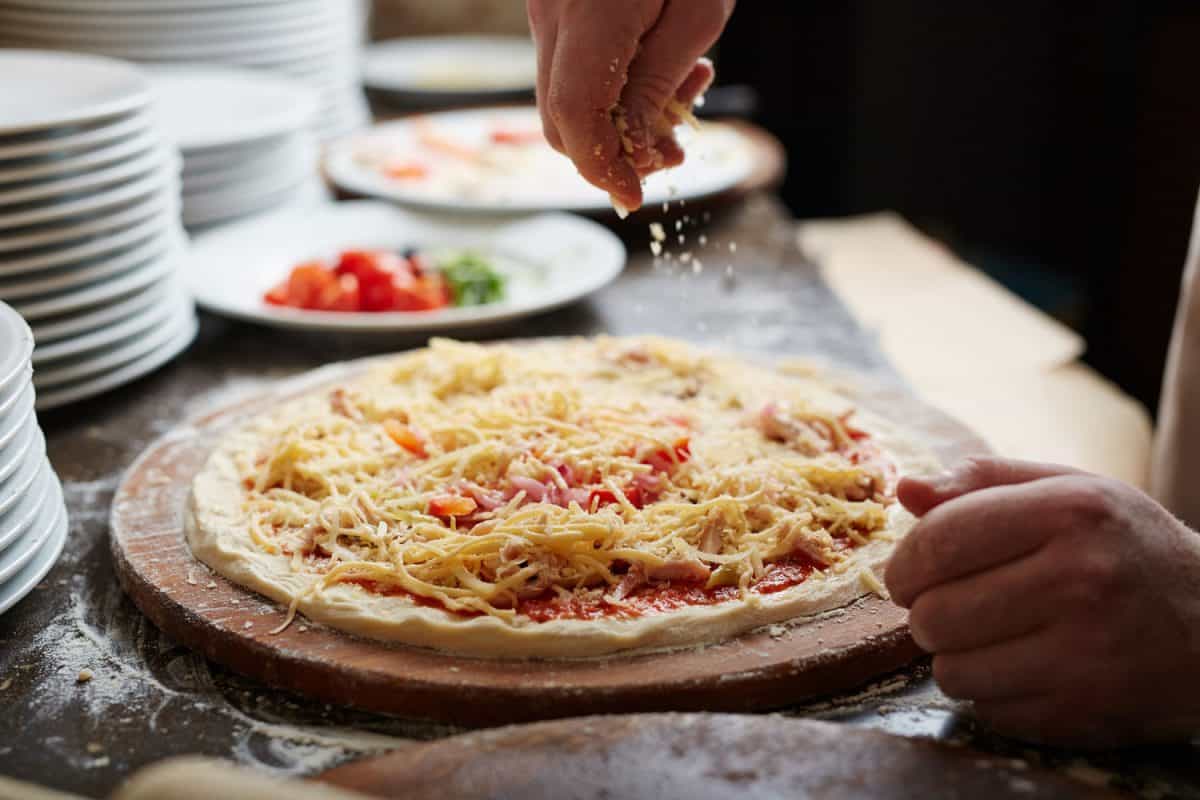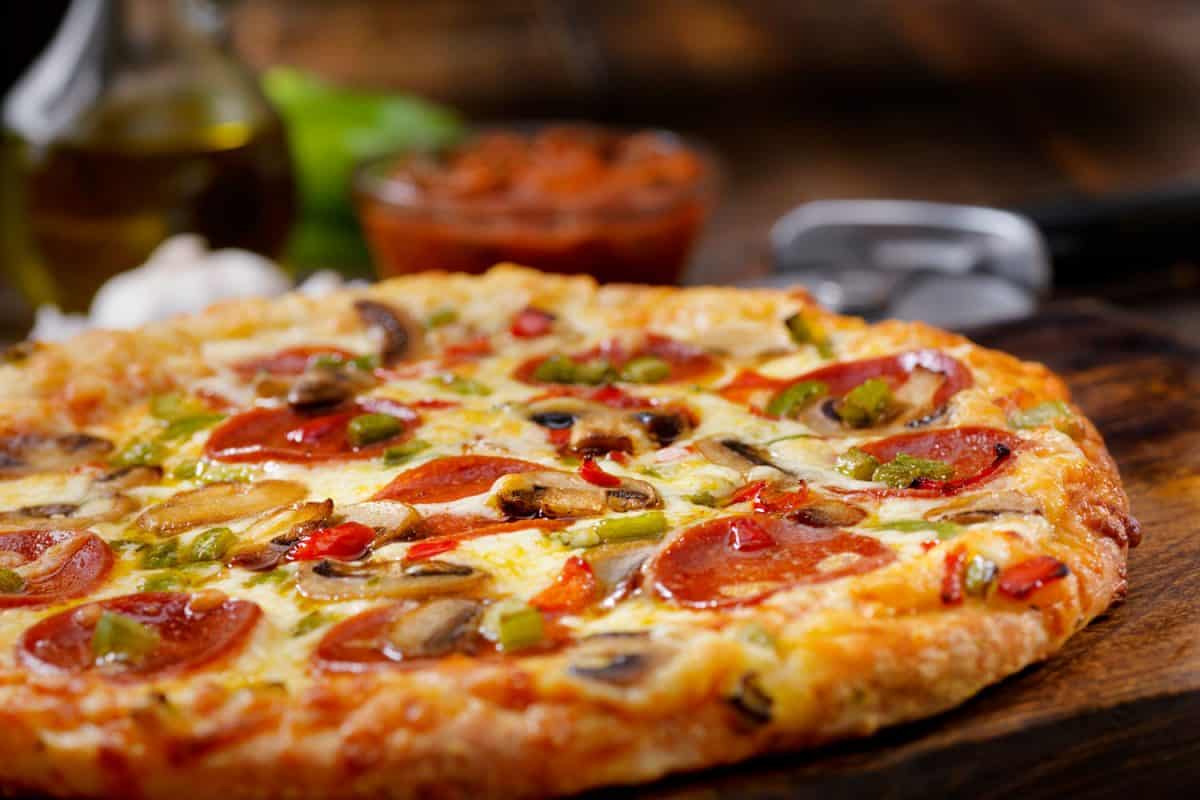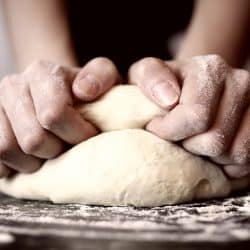Everybody loves pizza! What makes a pizza so delectable is the countless number of toppings you can use. But if you're making your own pizza, you may start to wonder whether pizza toppings go on top of the cheese or under it. You have come to the right place. We have looked into the best ways to top pizza.
Whether or not pizza toppings go on top of the cheese or under it depends on what the topping is. Pizza toppings that will dry out and burn should be placed under the cheese.
We will elaborate further on this topic. Continue reading to learn whether or not you should bake pizza dough before adding toppings, how to cut vegetables for pizza toppings, whether or not you should precook vegetables and meat for topping pizza —and more topping tips! We will also discuss reasons your pizza might be soggy, how to make your crust crispy, and what temperature is best for baking pizza.

How to Top Your Pizza
The best way to top your pizza depends on what toppings are your favorites. Think about whether or not the topping will dry out during the cooking process. If it does, it will burn if it is on top of the cheese. Usually, meats are best when baked on the top of the pizza, while vegetables come out better when baked under the cheese.

Placing toppings on top of the cheese can result in them being too crispy. Meat is best on top of the cheese because it still tastes good when it is crispy, and some people prefer it that way.
You do not want the vegetables on top of your pizza to dry out. They lose flavor when this happens. Their texture also changes, depending on where you place them. A good reason for placing toppings beneath the cheese is that it prevents your toppings from becoming overcooked.
Choose the best option for you when deciding how to top your pizza based on your desired outcome. If you are not a meat lover, then you should probably put your toppings under the cheese. As for meat lovers, you can add the meat to the top of your pizza without too much concern that it will dry out.
Should you bake pizza dough before adding toppings?

In general, you do not necessarily need to bake the dough before adding any toppings. It totally depends on how you are making your pizza and what you are adding.
The most important time to bake your pizza dough before adding toppings is when you add something that is wet. An example of this would be when you are using fresh mozzarella. Mozzarella can be bought as fresh or low-moisture; low moisture is preferable for pizza.
You can shred or grate mozzarella at home. Since it is a soft cheese, you should put it in your freezer for 15 minutes before you shred or grate it.
Some other wet ingredients that you might top your pizza with include, but are not limited to jalapenos, pineapple, artichoke hearts, and banana peppers.
Consider what toppings you are adding to your pizza before deciding whether or not to bake the dough prior to adding them. Bake your pizza dough for 6 to 10 minutes before adding your toppings of choice.
Fresh Pizza Dough
The typical ingredients for fresh pizza dough are as follows:
- Unbleached enriched wheat flour
- Water
- Sugar
- Soybean oil
- Salt
- Yeast
Watch this step-by-step video to learn how to make the perfect, fresh pizza dough:
Gluten-free Pizza Dough
For gluten-free pizza dough, you just need to use gluten-free flour instead of wheat flour. A few examples are almond flour, rice flour, and arrowroot flour.
Another option for gluten-free pizza dough is made by substituting cauliflower. Some starches used in gluten-free pizza dough include potato starch and tapioca starch.
Gluten-free ingredients for pizza toppings include spinach, artichokes, black olives, onions, peppers, garlic, tomatoes, and pineapple.
What cheese goes on homemade pizza?
You have a few choices when it comes to which cheese to put on your homemade pizza. The most commonly used cheese for pizza is mozzarella. Mozzarella is perfect for pizza because it is minimally processed, melts well, tastes fresh, and has a light creamy texture. It is the classic cheese you will find on Italian pizza.
Some other favorite cheeses for pizza are Gorgonzola, Parmigiano, Provolone, Cheddar, and Pecorino-Romano. Have you ever heard of four-cheese pizza? This type of pizza includes Mozzarella, Gorgonzola, Fontina, and Parmigiano.
How do you cut vegetables for pizza?
When cutting vegetables for pizza, you want to make sure you cut them to be very similar in size. This is important so that all of the vegetables will cook the same and taste the same.
Vegetables used for pizza toppings should be cut fairly small. If they are too big or chunky, they will take longer to cook than everything else on the pizza. This will either result in undercooked vegetables or overcooked cheese and crust.
You should cut your root vegetables into cubes and roast them prior to placing them on your pizza. Vegetable pieces being used as pizza toppings should not exceed half of an inch.
Onions are best for pizza topping when thinly sliced into slivers or diced into relatively small squares. They have the potential to dry out therefore it is a good idea to place onions under the cheese on your pizza.
Do you pre-cook vegetables for topping pizza?
It is a good idea to pre-cook the vegetables when topping your pizza. Bake them until they are slightly soft, and they will brown during the final cooking stages. By pre-cooking your vegetables the right way, you are enhancing their flavor. Vegetables become sweeter when cooked. They soften during the cooking process too.
When pre-cooking root vegetables for your pizza toppings, you should get out a cookie sheet first. Next, coat them in a thin layer of butter or oil and roast them in the oven or an air fryer. Roast your vegetables long enough that they are almost cooked through prior to adding them to your pizza.
When adding vegetables that are moist, like zucchini, mushrooms, or artichoke hearts, you should saute them in oil over medium heat before adding them to your pizza.
Do you pre-cook meat for topping pizza?

It is always a good idea to pre-cook the meat for topping pizza. This is because the baking time is based on how long the cheese will take to melt and the crust to brown.
Pizza is not meant to bake so long that raw meat would have the time to cook thoroughly. Sausage, chicken, and bacon are three examples of meaty pizza toppings that should be cooked before baking your pizza.
It is essential to make sure the meat that you choose for your pizza topping(s) reaches the correct internal temperature to be considered fully cooked.
Why is my pizza soggy?
There are a few reasons as to why your pizza is soggy. You may have used too much sauce. This prevents the pizza from heating properly.
If you want your pizza to bake evenly, try to distribute the toppings evenly. This requires spacing the toppings accordingly.
Another reason your pizza is soggy might be because you added fresh mozzarella or a different wet ingredient without baking the crust before adding that topping.
When you have too much sauce or cheese on your pizza, those toppings create a barrier. This causes a problem by preventing the heat from being evenly distributed. The temperature of the oven also affects whether or not your pizza comes out soggy.
What oven setting is best for pizza?
The oven setting that is best for pizza depends on the pizza. In most cases, the best temperature for baking pizza is between 400 and 500 degrees Fahrenheit. When using a pizza stone, bake your pizza on a lower oven rack than you would otherwise.
If the crust on your pizza is thick, you should cook it for 5 to 10 minutes prior to adding your toppings. You should always preheat the oven before placing the pizza into it.
Frozen pizza from the grocery store takes an average of 15 minutes to bake. Homemade pizzas take a little longer to bake thoroughly. Check out the video below for homemade pizza cooking tips:
How do I make the bottom of my pizza crispy?
There are a few ways to ensure the bottom of your pizza crust comes out crispy. Baking your pizza at the right temperature is an important factor.
Choosing the right pizza pan is one way to make the bottom of your pizza crispy. The bottom of your pizza will be crispier if you bake it on a perforated pizza pan or directly on the oven rack than it will by using a pizza stone.
To make crispy pizza avoid too much moisture. This requires you to pre-cook your vegetables and meats and to be aware when using fresh mozzarella.
Thick crust takes longer to bake. Chicago-style pizza is a deep-dish pizza, so it takes a little longer to cook. New York-style pizza is thin and slightly easier to bake crispy.
In Closing
You should bake your pizza dough before adding your toppings when they are wet because the pizza will be soggy otherwise. You should pre-cook both vegetables and meat before adding them to your homemade pizza.
Depending on how many toppings you are adding to your pizza and whether or not they are moist, you should most likely bake the dough before adding the toppings. You will end up with soggy pizza if you do not pre-cook the crust and moist ingredients.
In order to make your pizza dough crispy, you should choose an oven temperature between 400°F and 500°F. Perforated pizza steels are another way to ensure your pizza crust comes out crispy.
Before you go, check out the following links all about pizza for pizza lovers:
How To Prevent Pizza From Sticking To Tray
Pizza Tray Vs. Stone – What Are The Differences?
Do You Need To Grease A Pizza Tray? [Tips On How To Prepare One]





![Chef spreading tomato sauce in the pizza dough, How Much Pizza Dough Per Pizza? [By Pizza Size]](https://kitchenseer.com/wp-content/uploads/2022/02/Chef-spreading-tomato-sauce-in-the-pizza-dough-250x250.jpg)
